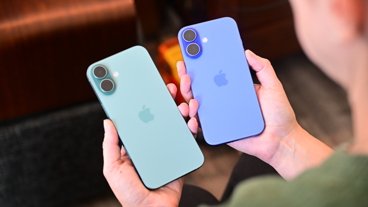Rather than relying on one piece of plastic or rubber, future cases for the iPhone may detect when it is about to hit the ground and alter physical properties to better protect your device.
We could just be more careful with our expensive iPhones, but Apple wants to minimize the chance of accidental damage by creating a new form of protective case. This active case will detect that you've dropped the iPhone and will actually strengthen itself before it hits the ground.
"Active electro-mechanical materials for protecting portable electronic devices," is a newly granted US patent which describes just how this could be done. The job is split between having a casing material that can respond, and how it can detect what Apple calls a "drop event."
"[Portable] electronic devices may be carried by protective cases to protect the portable electronic devices from shock caused by a drop event," begins Apple. "Although recent technological advances have led manufacturers of protective cases to incorporate a variety of different protective materials to protect these portable electronic devices, these different materials are insufficient to fully protect the portable electronic devices under a variety of different circumstances."
In other words, you can know that a drop would be bad, or that immersion in water wouldn't be great, but if you protected a device from absolutely everything, we'd never be able to use them. Choosing what Apple describes as a "passive material," such as rubber, plastic or leather, means making a choice over what the case will be able to protect.
"In particular, the passive materials are characterized as having a static damping coefficient," says Apple's patent. "[So] these passive materials cannot adjust for differences in magnitude of a drop event. For example, when an amount of force associated with an impact exceeds a damping threshold provided by the passive material, then the portable electronic device and its respective electronic components is likely to become damaged."
"Therefore, there is a need to utilize active materials that are capable of adapting to these variety of different circumstances," continues the patent.
Apple's solution is to have a case which is "capable of carrying the portable electronic device within [a] cavity," and then has walls that contain these proposed active materials. "[This type of case] also includes an active electro-mechanical material to adjust the amount of damping provided by the case according to the changing properties of the drop event."
So instead of one regular, passive material that will only protect so far, Apple wants a kind of combination material that will be active and changing to meet different conditions. "In some examples, the active electro-mechanical material includes magnetorheological elastomers (MRE) or electro-active polymers (EAP)," says Apple.
"When the active electro-mechanical material is exposed to an external stimuli (e.g., electrical field, magnetic field, etc.), then the active electro-mechanical material is activated.," the patent continues. "Subsequently, the stiffness or viscosity of the active electro-mechanical material is altered."
Apple says that this alteration will come from the "active electro-mechanical material is characterized as having material properties that are capable of undergoing changes when exposed to the influence of the external stimuli," including "a magnetic field," or "stress, temperature, moisture, and the like."
One significant example described in the patent concerns the use of magnetic particles included within "the matrix," the basic shell shape of the case.
"When the active damping layer is in a free (i.e., unstimulated configuration), the magnetic particles may be randomly distributed throughout the matrix," says Apple "However, when [it] is exposed to a magnetic field... the magnetic particles may become polarized and form chain-like clusters that are magnetically aligned with magnetic field lines associated with the magnetic field."
So the case can suddenly become stronger when you drop it. A key word there, though, is "suddenly," and the patent is also concerned with just how fast this alteration can take place. "[Once] the external stimuli is applied to the active damping layer, the active electro-mechanical material may undergo a change of material properties in a matter of a few milliseconds."
Before you've even noticed that your iPhone is heading for the ground, then, the active material can be stiffened — if the case knows it's been dropped.
Just as the Apple Smart Battery Case contains circuitry as well as silicone and the battery, so will a future protective case. "The walls [of the case will] carry operational components that include a processor capable of providing instructions," says Apple.
The patent is credited to Shravan Bharadwaj, whose previous patents include one about adding haptic feedback to Apple Watch bands.
 William Gallagher
William Gallagher








-m.jpg)






 Christine McKee
Christine McKee
 Charles Martin
Charles Martin
 Mike Wuerthele
Mike Wuerthele
 Marko Zivkovic
Marko Zivkovic
 Malcolm Owen
Malcolm Owen





-m.jpg)






6 Comments
Let's hope it is reversible. Or really really cheap.
Otherwise it might be less expensive to just let the iPhone drop...
This reminds me of the concept video called iPhone 7 - Parachute System
I know this is about drop protection, but... Imagine if they designed phones so that cases weren’t an utterly required add-on purchase. Like, the phone wasn’t too slippery to hold on to and not too thin to grip comfortably.
But yeah, let’s just start making crazy cases because buying an expensive shell for the expensive and brittle device you just bought has become a norm and now it’s one more place to make profits via “features”.